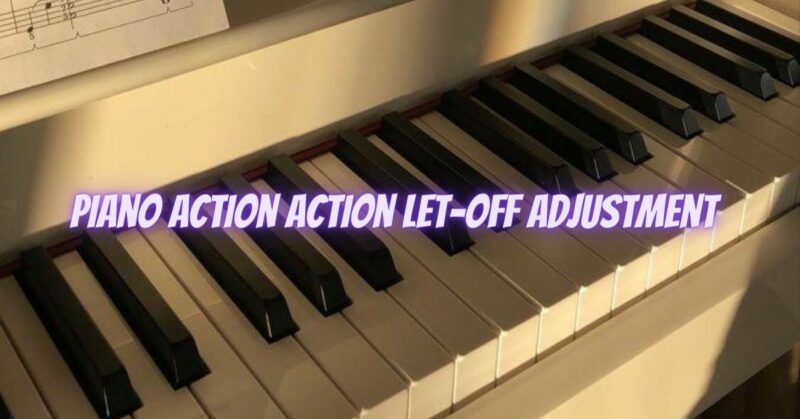The let-off is a critical aspect of a piano’s action mechanism that directly influences the level of control and precision a pianist can achieve during performance. Adjusting the let-off is part of the intricate process of piano action regulation, and it plays a vital role in fine-tuning the instrument’s touch and responsiveness. In this article, we will explore the piano action let-off adjustment, its significance, and the benefits it offers to pianists.
Understanding Let-Off: In a piano action, the let-off is the point at which the piano hammer disengages from the piano key’s escapement mechanism. The escapement mechanism allows the hammer to escape or release from the jack (a small lever) when the key is pressed down, enabling the hammer to travel towards the piano string to produce sound. The let-off point determines how far the hammer needs to be lifted from the string before it disengages, and this distance affects the level of control and precision a pianist has over the touch and articulation of the notes.
Piano Action Let-Off Adjustment: The piano action let-off adjustment involves altering the distance between the hammer and the string at which the hammer disengages. Technicians achieve this by regulating the position and alignment of the let-off buttons, which are felt-covered components that interact with the hammers. By carefully adjusting the let-off buttons, the technician can determine precisely when the hammer will disengage from the escapement mechanism.
The Regulation Process:
- Evaluation: A skilled piano technician will assess the current let-off of the piano by observing the action mechanism’s interaction with the hammers and let-off buttons.
- Adjustment: To adjust the let-off, the technician will carefully position the let-off buttons. If the let-off point is too close to the strings, resulting in an early disengagement, the technician will move the buttons slightly farther from the strings. Conversely, if the let-off point is too far from the strings, causing a delayed disengagement, the buttons will be positioned closer to the strings.
- Testing and Refinement: After making the initial adjustments, the technician will test the piano’s touch and responsiveness. Fine-tuning may be necessary to achieve the desired let-off point that offers optimal control and precision.
Importance of Let-Off Adjustment: Adjusting the let-off in a piano action offers several key benefits:
- Articulation Control: Proper let-off adjustment enables the pianist to control the hammer’s escapement precisely, allowing for clearer and more defined note articulation.
- Responsive Touch: An appropriately regulated let-off ensures that the piano action responds instantly to the pianist’s touch, providing a seamless playing experience.
- Dynamic Expression: A well-regulated let-off allows for greater dynamic range and expressiveness, as the pianist can control the hammer’s release and create varying levels of volume and intensity in the music.
- Precision and Accuracy: Accurate let-off adjustment ensures that the piano plays evenly across all keys, enhancing the accuracy and consistency of the pianist’s performance.
Seeking Professional Assistance: Piano action let-off adjustment is a delicate process that requires technical expertise and precision. Attempting to adjust the let-off without the proper knowledge and tools may lead to damage or negatively impact the piano’s playability. It is essential to consult a qualified piano technician for this intricate adjustment.
Conclusion: The piano action let-off adjustment is a crucial step in piano action regulation that significantly impacts touch, control, and responsiveness. A well-regulated let-off enables the pianist to achieve precision, dynamic expression, and accuracy in their playing. To ensure that your piano is at its best performance level, regular action regulation, including let-off adjustment, is essential. By seeking professional assistance and periodic maintenance, you can optimize your piano’s playability and enjoy a rewarding and expressive musical journey.


